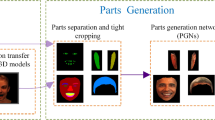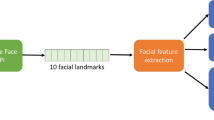Abstract
Precisely editing user specified facial attributes has wide applications in areas such as virtual makeup, face aging, facial expression transfer, face synthesis. However, it is difficult to explicitly control individual facial attribute due to the gap between high level semantics in human perception and feature vectors in latent space. In this paper, a semantic disentanglement algorithm interpreting the latent space of GAN is proposed, which can be employed to extract attribute control vector adaptive to individual face. By adjusting the coefficient of extracted control vector, variation of single attribute is realized. Then, comprehensive modification effect of facial attributes is obtained through the superposition of control vector. Classification and content loss functions are introduced to limit modification occurs to the specified attribute without affecting the other attributes. As a result, precise editing control is realized.











Similar content being viewed by others
References
Goodfellow, I., Pouget-Abadie, J., Mirza, M., et al.: Generative adversarial nets. In: Advances in Neural Information Processing Systems pp. 2672–2680, (2014)
Shen, Y., Gu, J., Tang, X., et al.: Interpreting the latent space of gans for semantic face editing. In: Proceedings of the IEEE/CVF Conference on Computer Vision and Pattern Recognition pp. 9243–9252, (2020)
Mirza, M., Osindero, S.: Conditional generative adversarial nets, arXiv preprint arXiv:1411.1784 (2014)
Chen, X., Duan, Y., Houthooft, R., et al.: Infogan: interpretable representation learning by information maximizing gener-ative adversarial nets. In: Advances in Neural Information Processing Systems pp. 2172–2180, (2016)
Shoshan, A., Bhonker, N., Kviatkovsky, I., et al.: GAN-Control: explicitly controllable GANs, arXiv preprint arXiv:2101.02477 (2021)
Zhu, J.Y., Park, T., Isola, P., et al.: Unpaired image-to-image translation using cycle-consistent adversarial networks. In: Proceedings of the IEEE International Conference on Computer vision pp. 2223–2232, (2017)
Choi, Y., Choi, M., Kim, M., et al.: Stargan: Unified generative adversarial networks for multi-domain image-to-image translation. In: Proceedings of the IEEE Conference on Computer Vision and Pattern Recognition pp. 8789–8797, (2018)
KIM, T., CHA, M., KIM, H., et al.: Learning to discover cross-domain relations with generative adversarial networks, arXiv preprint arXiv:1703.05192 (2017)
Lample, G., Zeghidour, N., Usunier, N., et al.: Fader networks: manipulating images by sliding attributes. In: Advances in Neural Information Processing Systems pp. 5967–5976, (2017)
Shen, W., Liu, R.: Learning residual images for face attribute manipulation. In: Proceedings of the IEEE Conference on Computer Vision and Pattern Recognition pp. 4030–4038, (2017)
Perarnau, G., Van De Weijer, J., Raducanu, B., et al.: Invertible conditional gans for image editing, arXiv preprint arXiv:1611.06355 (2016)
Harkonen, E., Hertzmann, A., Lehtinen, J., et al.: Ganspace: Discovering interpretable gan controls, arXiv preprint arXiv:2004.02546 (2020)
Shen, Y., Zhou, B.: Closed-form factorization of latent semantics in gans, arXiv preprint arXiv:2007.06600 (2020)
Zhang, Z., Song, Y., Qi, H.: Age progression/regression by conditional adversarial autoencoder. In: Proceedings of the IEEE conference on computer vision and pattern recognition pp. 5810–5818, (2017)
HE, Z., ZUO, W., KAN, M., et al.: Arbitrary facial attribute editing: only change what you want, arXiv preprint arXiv:1711.10678, 1(3) (2017)
Isola, P., Zhu, J.Y., Zhou, T., et al.: Image-to-image translation with conditional adversarial networks. In: Proceedings of the IEEE Conference on Computer Vision and Pattern recognition pp. 1125–1134, (2017)
Yin, W., Fu, Y., Sigal, L., et al.: Semi-latent gan: learning to generate and modify facial images from attributes, arXiv preprint arXiv:1704.02166 (2017)
Natsume, R., Yatagawa, T., Morishima, S.: Rsgan: face swapping and editing using face and hair representation in latent spaces, arXiv preprint arXiv:1804.03447 (2018)
JIANG, S., TAO, Z., FU, Y.: Segmentation guided image-to-image translation with adversarial networks. In: 2019 14th IEEE International Conference on Automatic Face & Gesture Recognition (FG 2019), pp. 1-7 (2019)
Jo, Y., Park, J.: SC-FEGAN: face editing generative adversarial network with user’s sketch and color. In: Proceedings of the IEEE International Conference on Computer Vision pp. 1745–1753, (2019)
Zhu, J., Zhao, D., Zhang, B.: Lia: latently invertible autoencoder with adversarial learning, arXiv preprint arXiv:1906.08090 (2019)
Karras, T., Laine, S., Aila, T.: A style-based generator archi-tecture for generative adversarial networks. In: Proceedings of the IEEE Conference on Computer Vision and Pattern Recognition pp. 4401–4410, (2019)
Karras, T., Aila, T., Laine, S., et al.: Progressive growing of gans for improved quality, stability, and variation. In: International Conference on Learning Representations (2018)
Arjovsky, M., Chintala, S., Bottou, L.: Wasserstein gan, arXiv preprint arXiv:1701.07875 (2017)
Acknowledgements
This paper was sponsored by the Public Welfare Research Project of Zhejiang Province, China (Grant No. LGF18F020015), Opening Foundation of Key Laboratory of Fundamental Science for National Defense on Vision Synthetization, Sichuan University, China (Grant No. 2020SCUVS007), Opening Foundation of Zhejiang Police College, China (Grant No.2020DSJSYS002), and JSPS Grants–in–Aid for Scientific Research, Japan (Grant No. 17H00737), and Key Laboratory of Brain Machine Collaborative Intelligence of Zhejiang Province, China.
Author information
Authors and Affiliations
Corresponding author
Ethics declarations
Conflict of interest
We declare that we do not have any commercial or associative interest that represents a conflict of interest in connection with the work submitted.
Additional information
Publisher's Note
Springer Nature remains neutral with regard to jurisdictional claims in published maps and institutional affiliations.
Rights and permissions
About this article
Cite this article
Ju, Y., Zhang, J., Mao, X. et al. Adaptive semantic attribute decoupling for precise face image editing. Vis Comput 37, 2907–2918 (2021). https://doi.org/10.1007/s00371-021-02198-z
Accepted:
Published:
Issue Date:
DOI: https://doi.org/10.1007/s00371-021-02198-z




